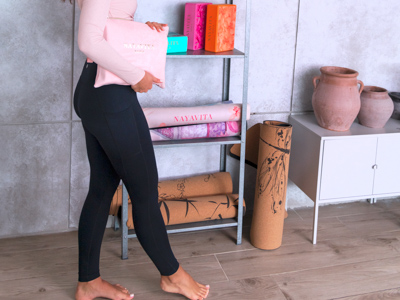How to choose a yoga mat
Not sure how to choose a yoga mat that’s right for you? Fear not. We’ve got you. There are six key criteria everyone should consider before deciding what mat to buy.
Just like the number of yoga and exercising styles may seem overwhelming, so can the sheer variety of mats. But with the right guidance, picking a mat is easy.
Here it goes. Let’s choose a yoga mat that’s right for you:
1. Type of exercise or yoga
More dynamic exercises and yoga like Ashtanga, Vinyasa and Hot Yoga are better suited for absorbent mats with an extra grip. Among natural materials, cork is anti-slip, anti-microbial and non-allergenic. It’s also super easy to maintain, making it a very popular choice. Vegan Suede mats from recycled microfiber is a suitable alternative. Faux suede is super absorbent, anti-slip (the more you sweat, the more it holds), and when you’re done, just wipe your mat down with a clean cloth or if needed, wash it by hand and voilà. If you do Hot Yoga, consider a yoga towel or suede travel mat that fulfils the same function.
Less dynamic exercises, stretching, Yin Yoga and Hatha Yoga don’t require a specific mat. Any standard mat even of average quality is sufficient, as long as it is not slippery. Here you can let your visual preference guide your choices. Although when it comes to Yin Yoga where you hold positions for prolonged periods of time, digging your bones into the ground, mat thickness is an important factor. Thicker mats provide better comfort during Yin Yoga.
2. Material and sustainability
Material determines mat properties, ease of maintenance, ego-friendliness and is important to avoid allergies and fit personal preferences.
If you, like us, find sustainability important, go with natural and / or recycled materials. Cork, rubber, jute, cotton, as well as vegan suede are all great options. Your mat should be biodegradable or at least recyclable.
The alternative is to go less eco and more synthetic like PVC, TPE and PU. PVC ‘s durability makes it a popular material, but it’s production and composition are often harmful to the environment, and through prolonged exposure to you.
3. Your physique
To start with, the length of your mat should be enough to support you during savasana and lying down positions. Most standard mats are between 171 – 183cm long, although few brands offer extra long options.
Then there is thickness. Thinner mats provide minimal cushioning between you and the floor. Pre-existing conditions like joint problems should also be taken into account when deciding how to choose a yoga mat. In this case, we recommend 3mm and more.
4. Where you exercise
Where you exercise is important. Home practice is logistically straightforward, and you can consider thicker and heavier mats, if that’s what you like.
Studio nomads, outdoors enthusiasts and travellers might want to select thinner and lighter travel mat, especially when they come with their own pouch or a bag for extra portability.
5. Your style and aesthetics
It’s no secret that our environment impacts how we feel and think, so underestimating yoga mat aesthetics is not advisable. Surround yourself with beauty and you will feel more beautiful. It’s not a coincidence that our NAYAVITA YOGA motto, is
For the goddess in studio and out
6. Your budget
If your budget is limited, or you are just starting out and not sure if exercising is your jam, Amazon, AliExpress and Decathlon all have mats for as little as €10. If, on the other hand, you want to treat yourself to that ‘perfect’ mat that will give you everything you need, prices can climb up to four figures.
Higher prices don’t always mean better quality, although it is often the case. That doesn’t mean that you need to blow up your budget on an overpriced mat where you pay premium for the brand. Many boutique stores like NAYAVITA YOGA offer original high quality mats for affordable prices, that are intuitively functional and look great to boot.
Mat comparison
Hopefully these six criteria shed some light on how to choose a yoga mat that’s right for you. To make it even easier, here is a comparison using these criteria:
| Cork mats | Suede mats | Travel mats | |
| Size | 181 x 61 cm | 183 x 61 cm | 173 x 61 cm |
| Thickness | 3.5 mm | 3 mm | 1 mm |
| Weight | 2.2 – 2.5 kg | 1.8 – 2.2 kg | 0.8 – 1.1 kg |
| Material | Cork & natural rubber | Recycled suede (microfiber) & natural rubber | Recycled suede (microfiber) & natural rubber |
| Joint support | High | Standard | Low |
| Best for | All yogis, including dynamic exercises (Ashtanga, Bikram, Pilates, etc.) | All yogis, including dynamic exercises (Ashtanga, Bikram, Pilates, etc.) | Yogis on the go |
| Biodegradable | Yes | Yes (natural rubber) | Yes (natural rubber) |
| Recycled | No | Yes (suede) | Yes (suede) |
| Recyclable | Yes | Yes | Yes |
| Hand-washable | No | Yes | Yes |
Namaste yogis!
Whatever your decision, remember that yoga mat does not determine your practice. Sure, it’s great having top of the range beautiful mat and matching gear. It can also be a priceless motivation. But lack thereof shouldn’t stop you from exercising here and now.
Sending you love and harmony!







Leave a Reply